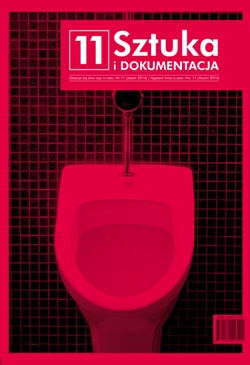Mobilność sztuki: fotografie i druki konceptualne Romualda Kutery
The mobility of Romuald Kutera’s works
Author(s): Sylwia SerafinowiczSubject(s): Fine Arts / Performing Arts
Published by: Akademia Sztuk Pięknych w Gdańsku
Keywords: Romuald Kutera; Anna Kutera; mobilność; sztuka konceptualna; artziny; slajd; lata siedemdziesiąte; Sztuka Pojęciowa; Jerzy Ludwiński; Sympozjum Wrocław’70; mobility; conceptual art; artzines; slides; Seventies; Concept Art
Summary/Abstract: Mobility is an indispensable part of conceptual practice. Its main mediums - photographs, slides, drawings and texts – allowed artists the possibility of circulating their works relatively easily, both in Poland and abroad. Smaller works, whose dimensions did not exceed the A4 format, were sent by post. The bigger ones were often transported in suitcases. In the late sixties and in the seventies, this strategy was often employed by radical conceptual artists to reach beyond the existing art scene and create an alternative. The process was triggered by a new, and faster means of travel, which had not been available to the previous generations of artists. Consequently, Romuald Kutera’s oeuvre consists of numerous projects intended to be displayed abroad. Perhaps the most intriguing one is his work from 1985 My History of Art. It measures 111 cm by 206 cm and was prepared to be shown at the Contemporary Art from Poland which opened at the Walter Phillips Gallery in Banff in 1985. It was later transported by Anna Kutera to Toronto and exhibited at the Artculture Resource Centre. Another work shown in Banff was created by Anna Kutera following Romuald’s directives dictated by telephone and further tips sent by post. Another popular method of transmitting the message of a conceptual work from the sixties onwards was by telephone. This solution was pioneered by László Moholy-Nagy in 1923 when his avant-garde works Konstruktion in Emaille 2 and 3 were prepared by a local enamel manufacturing plant following the artist’s telephone instructions. Conceptual ideas travelled also in print. In 1973, Romuald Kutera together with Anna Kutera, Wiesława Siwicka, Mirosław Gliński, and Piotr Błażejewski, who were all members of the Recent Art Gallery collective set up the previous year, created Publication. Key fi gures of the American art scene, including Sol LeWitt in his Paragraphs on Conceptual Art (1967), emphasised the lesser importance of the material and visual layer of an artwork compared to its idea. Publications played a key role in conveying information about actions undertaken in remote and rather insignifi cant places like Osieki, Turów, or Rozel Point, Utah. From the late sixties onwards, slides, photographs and texts enabled artists to communicate their ideas, fi nd allies and a way to show their work in places that they could not reach in person. Due to the light and compact character of materials used by conceptual artists, their art could venture beyond their circle of friends, their cities and eventually continents. Artworks could even be made while travelling and in the open air. Therefore Romuald Kutera’s objects are not only a registration of his artistic ideas from the seventies until today but they also document his journeys, meetings and conversations.
Journal: Sztuka i Dokumentacja
- Issue Year: 2014
- Issue No: 11
- Page Range: 11-17
- Page Count: 7
- Language: Polish

